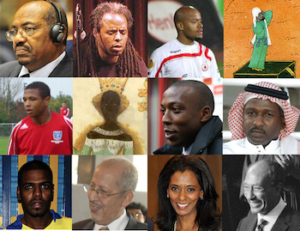
*Afro Arabians are celebrated on this date in 700 BCE. Afro Arabs are a sub-Saharan society.
They are indigenous Black Africans of the continent, comprised mainly of Sudanese, Egyptians, Moroccans, Algerians, Sahrawis, Mauritanians, Yemenis, and Tunisians. These are long-established communities in Gulf states, including Oman, Saudi Arabia, Kuwait, and the United Arab Emirates. There are also smaller communities of Afro Arabs among Palestinians, Jordanians, Iraqis, and Libyans. Eastern Arabia and Africa have been in contact since the 7th millennium, marked by the obsidian exchange networks. BCE.
The rise of the Egyptian dynasties of the 4th millennium strengthened these networks. Scientists believe that settlements in Arabia, originating from the Horn of Africa, existed as early as the 3rd and 2nd millennia, and continued. The Afro Arabian Tihama culture originated in Africa and began in the 2nd millennium. This cultural complex is located in Adulis, Eritrea, as well as in Ethiopia, Sudan, Yemen, and the Saudi coastal plains. In the 12th century, Southern Arabs gained control of the Red Sea trade routes and established the first kingdom, Saba, in Yemen at around 800 B.C. As a result, modern-day Eritrea and Ethiopia were gradually incorporated into the area of Arab influence.
In 600 BCE, the Ethio-Sabean state of Daamat emerged on the Tigrean plateau. "The archaeological evidence shows this came from colonization by several Arabian groups and the acculturation of the indigenous population." After several centuries of isolation, the kingdom of Aksum arose in 100 AD. Aksum survived for 800 years and occupied southern Arabia for part of this period. Utilitarian Aksumite pottery has been found in large quantities in deposits from the 5th and 6th centuries in the Yemen Hadramawt, suggesting that there may have been substantial immigration during that period.
By around the 1st millennium AD, Bantu fishermen established trading towns on what is now called the Swahili Coast, which became Arabized between the 10th and 12th centuries. The Portuguese conquered these trading centers after the discovery of the Cape Road. From the 1700s to the early 1800s, Muslim forces of the Sultanate of Muscat reseized these market towns, especially on the islands of Pemba and Zanzibar. Arabs from Oman and Yemen mingled with the local "negro" populations in these territories, establishing Afro Arab communities.
The Niger-Congo Swahili language and culture primarily evolved through these intermarriages between Arab and native Bantu women. Afro Arab communities were founded in the Nile Valley, as Arabs intermarried with indigenous tribes in Sudan. However, many other Afro Arabs in Sudan had little biological connection to Arab peoples. Still, they were essential to Nilotic origins, albeit influenced by the old Arabian language and culture. In the mid-to-late 1800s, Arab traders began to move into the central African interior to pursue the ivory trade.
Unlike other cases of racial mixing, Arabs, mainly from the Persian Gulf, generally did not view Afro Arabs as half-caste; if the father was Arab, Afro Arabs enjoyed similar statuses in their societies. Thus, after the Zanzibar Revolution of 1964, many Afro Arabs who left and settled in Oman could attain high political and diplomatic positions and be accepted as Arabs.
Racial assimilation of Afro Arabs with non-Arab Africans also aided Muslim missionaries in spreading Islam throughout Africa. However, this is not the case for the Afro Arabs of North Africa. In contrast, racial discrimination still plays a significant role in segregating Afro Arabs from the mainstream Arab population, as found in Tunisia, Algeria, Libya, and Morocco.
In the Arab states of the Persian Gulf, descendants of people from the Swahili Coast perform traditional Liwa and Fann At-Tambura music and dance. Afro Arabs also perform the mizmar in the Tihamah and Hejaz regions of Saudi Arabia. The ancestors of these Black Africans were initially brought to the Arabian Gulf as enslaved people. Today, however, they are fully recognized citizens of the Persian Gulf States, despite not having Arab ancestry. In addition, Stambali of Tunisia and Gnawa music of Morocco are ritual music and dances that trace their origins to West African musical styles.